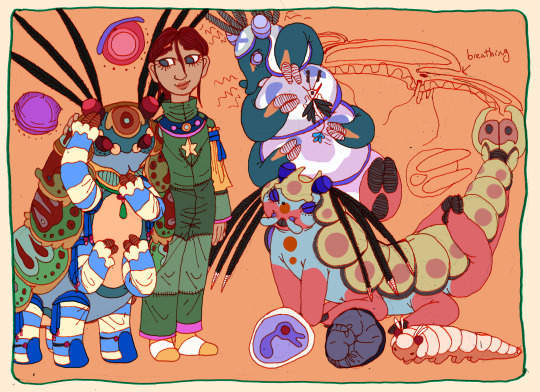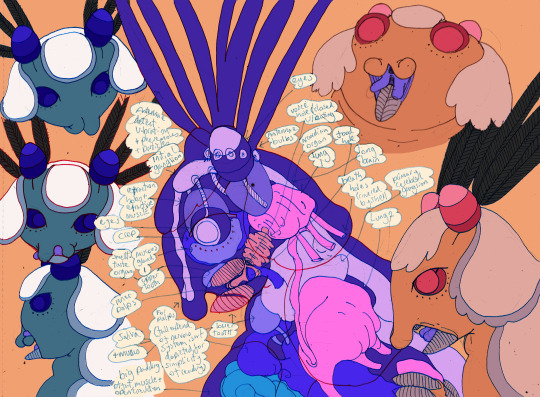#new deep kkariko lore - their poop is hard and they fart
Text


all about kkariko! the infodump is finally ready.
kkariko are soft-bodied invertibrate creatures hailing from a planet known as rika. they're social and familial, living in highly complex family groups. they also make extensive use of tools and accessories in their daily lives. in this way, their behavioral model resembles the behavioral models of humans, but kkariko have some major differences too. an example - kkariko have five "sexes" - or maybe they have no sexes? all kkariko are born "neuter", with the organs used for recreation vestigal in their bodies. however, kkariko can develop into one of four "sexual" sexes to play certain roles in mating and infant rearing. kkariko are able to switch sex multiple times in their lives - it's seen as cosmetic to them. the five socially recognized kkariko sexes are thus: neuter sex, the sex which kkariko are born as. egglayer sex, the sex which can inject pheromones into another kkariko, receive "spermatophores", and lay eggs. inseminator sex, the sex which can make "spermatophores" (actually more like "spear" matophores). brooding sex, the sex which can grow a pouch and grow eggs in it and feed babies using their specialized mouth organ. and finally, protector sex, which also has a special mouth organ and a "spine" for protecting babies.
kkariko babies start life as eggs. eventually, they hatch, and just look like tiny little kkariko. kkariko at such a young age molt many times, and with each molt, they grow more and more. molting intensity usually tapers off after the 27th molt, and size change only gets smaller and molt frequency lower as kkariko age. kkariko have very high infant mortality rates - on average, a clutch of kkariko eggs numbers 20, but its considered lucky if just 4 survive to their 27th molt. rrikrik was in a clutch of 17, but half were laid "out of pouch" (common in almost all kkariko cultures, ensures that brooder attention isn't so divided) and only two ended up hatching.
kkariko have two possible pigments used in their skin. one pigment creates red/pink colors, whilst the other creates blue/gray colors. both can coexist on a single body - like a calico cat - as well as patches of different intensity of pigmentation which can produce darker or lighter pigmentation. these pigments also determine the eye color of kkariko. however, kkariko tend to have a "base color" which affects the tint on their exoskeletons. base color isn't neccesarily the most abundant color on a kkariko.
their bodies are long and squishy, with thick, highly pressured "blood" keeping their muscles and organs in place. kkariko have four pairs of legs, and they alternate between an all-legs undulatory gait and a quadrapedal four beat gait depending on the movement speed and additional actions required of them. they can also stand up on their back legs for intimidation points. but their balance is pretty bad in this state and they can't walk without lots of practice and lower leg strength. at the end of each limb, they have three digits encased in flexible exoskeleton. two digits at the very end of the limb, and one slightly down. these digits can be used to grasp things and manipulate objects, although they're generally clumsy. they also have a long, fat, tapering tail. this tail can be moved independently, but is usually just dragged along the ground behind the kkariko due to its weight. kkariko have a small, round head at the end of their body, where many of their sensory organs are.
kkariko heads are pretty simple. it is on their head that a kkariko has their two pairs of eyes, their primary mucus ducts, their facial palps, their antennae, their mouth, and their first lung. the first pair of kkariko eyes are kind of a hybrid between forward-facing and side-facing. they've got a wide degree of vision. this eyeset sees pretty well, and is generally used to identify objects near the kkariko's face. for this reason, they're nearsighted. the second pair of eyes sits above the kkariko's head and protude upwards. this pair can see nearly 260 degrees around the kkariko, and experiences vision in a very abstracted way, largely triggered by bright colors and movement. these eyes also move independently of each other. as a prey animal, kkariko have evolved this set of eyes to continually watch around them as they use their first set of eyes to look for food and watch their friends. both eyes jut out from the head of the kkariko when in use. the lower set of eyes have a pair of semi-translucent eyelids which occasionally can hydrate the eye, but kkariko generally don't need to blink much. the upper pair of eyes don't need to blink at all, because they have a thick protective coating. both pairs of eyes are retractable, however, and when kkariko are getting ready to go sleep, they retract them back into their heads, with only a thin indigo line showing where they will pop out of later. just below their eyes is their primary mucus ducts, which produce a mucus which covers kkariko skin to keep it from drying out and getting burnt. there are more mucus ducts on their "wrists" and their tail.
the antennae sit behind the second pair of eyes, and are used to sense different types of waves and particles in the air. they process this into audible sound, vibrational information, and electromagnetic data. kkariko can have anywhere from three to five sets of antennae, and can grow an extra pair for sensing pheromones when engaging in sex. antennae can also be used to make a loud whirring noise when rubbed together or a low "clicking" noise when the bases of the antennae (known as "bulbs") grind together in the antennae sockets. these noises are recognized as distinct phones in kkariko language.
the mouth of the kkariko is typically hidden behind their exterior set of palps. these two tentacle-like appendages are used by kkariko to "taste" the air and food, to produce sounds, and to manipulate objects. kkariko palps have much finer motor control than their "hands", so delicate tasks like making art or preparing food are usually done using the exterior palps. behind these palps is the mouth. the mouth of the kkariko is indigo-violet (the color of their blood) and contains a pair of interior palps, two flat "teeth" used for crushing food, and a pair of holes, one used for communication and another used for eating. the interior palps are much thinner than the exterior palps, but serve the same purpose as their exterior friends. its a bit hard to use them to make art, as they can't reach that far outside the mouth. the lower tooth juts out of the mouth and can be moved with a good degree of freedom. when a kkariko's mouth is closed, it pushes up under the palps and the edges of the mouth retract around it, leaving the lower tooth as the only mouth organ visible. when the mouth is open, the lower tooth keeps it by moving down. the lower tooth and the upper tooth mash together to grind food up into a convenient paste, and then the interior palps and kkariko saliva helps move the food down to the esophagus, which is situated below the palps. above the palps is the kkariko's speech hole - closed during eating. kkariko are kind of messy eaters!
kkariko language is, as previously discussed, in part constructed around antennae sounds. but there is a vocal element of it too. kkariko have several groupings of lungs down their bodies, and the first lung sits at the back of their head just below their first cerebral ganglia, which is part of a long network which also travels all the way down their bodies. the lungs of the kkariko intake air from little holes underneath the "lip" of their back exoskeletons. this first lung is connected to the very end of their second exoskeleton plate, which wraps around their head to support it. connected to this lung is an "accordian" organ, which produces a melodious buzzing noise by expanding and contracting with pushed air from the lung out to the noise hole at the top of the kkariko's mouth. tone and intensity can be adjusted, and kkariko will adjust the position of their two pairs of palps and their tooth to make different noises with it. kkariko also rumble their teeth together and smack them together to speak.
on their backs, kkariko grow a heavy plated exoskeleton, used for defense and protection. this exoskeleton stretches from the head of the kkariko all the way down to their tail, ending in a spiked fanlike form which can be used to defend a kkariko. rika is very rich in metal, and heavy metals often enter kkariko diets via the plant life they eat. kkariko have very efficient filtering systems for both water and metals - water is recycled back into the body entirely and eventually expelled in defensive, stinking "farts", and metals are either pooped out in very hard and compacted dry poops, or stored in a specialized organ and used to built their exoskeletons during molts. this is where the colors in their exoskeletons come from - all the metals they eat. some of the metals even oxidize in air, and change color as time moves on! this metallic shell is very heavy, and because of that, kkariko have very strong and muscular bodies. the gravity on rika is also pretty strong, so that also aids in their big buff physiques. the exoskeleton restricts their movements somewhat - kkariko are able to move their limbs pretty freely, and can curl up into a tiny ball, but cannot arch their bodies back that far because the plates on their back prevent much movement. the kkariko in this sheet doing some sort of stretching is probably the extent to how far back a kkariko can stretch without hurting themselves.
kkariko culture is highly complex and varied. rika is hot and arid, and many kkariko live nomadic or seminomadic lives. i'll probably write another post about kkariko cultures, because this one is very long. i guess the most important thing to discuss here is kkariko fashion. kkariko are generally not very modest - they don't need to be, because their shell protects them from most weather. however, all cultures are different, and some kkariko do wear full-body clothing. the most common universal piece of clothing are "armwarmers", which wrap around the limbs like socks. kkariko often wear matching pairs for all eight of their limbs. bibs, hats, capes and aprons are also common, as well as tail aprons which protect the tail from sharp terrain when moving across the ground. tail aprons are a bit like underwear because they also cover genitals.
rowny and rrikrik for reference. rowny is 6ft tall.
v page i made when i was trying to figure out how kkariko communicate + kkariko funny faces v

#kkariko tag#xenobiology#speculative biology#sci fi#alien biology#alien species#the kkariko infodump....#new deep kkariko lore - their poop is hard and they fart#writing this two weeks after - “lung” structure has changed a bit. think of it less as a bag and more as a root system
82 notes
·
View notes